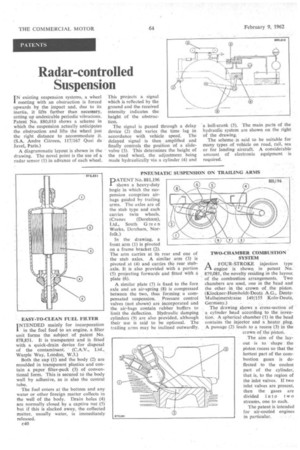Radar-controlled Suspension
Page 72

If you've noticed an error in this article please click here to report it so we can fix it.
I N existing suspension systems, a wheel meeting with an obstruction is forced upwards by the impact and, due to its inertia, it lifts farther than necessary, setting up undesirable periodic vibrations. Patent No. 880,010 shows a scheme in which the suspension actually anticipates the obstruction and lifts the wheel just the right distance to accommodate it. (S.A. Andre Citroen, 117/167 Quai de Javel, Paris.)
A diagrammatic layout is shown in the drawing. The novel point is the use of a radar sensor (1) in advance of each wheel.
This projects a signal which is reflected by the ground and the received intensity indicates the height of the obstruction.
The signal is passed through a delay device (2) that varies the time lag in accordance with vehicle speed. The delayed signal is then amplified and finally controls the position •of a slidevalve (3). This determines the height of the road wheel, the adjustment being made hydraulically via a cylinder (4) and a bell-crank (5). The main parts of the hydraulic system are shown on the right of the drawing.
The scheme.is said to be suitable for many types of vehicle on road, rail, sea or for landing aircraft. A considerable amount of electronic equipment is required.
















































































































